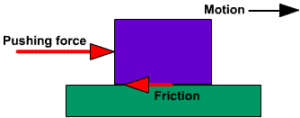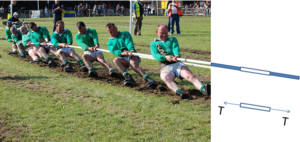There are several different types of forces that exist. One way of categorizing different forces is into contact and non-contact forces. A contact force requires something to be physically touching an object to exert force on it. A non-contact force does not require physical contact to act. An example of a contact force would be pushing a box across the ground. An example of a non-contact force would be gravity pulling someone to the ground when they jump off the ground.
Applied
 Applied forces are forces like pushing or pulling that are applied to a person or object by a person or object. An example of an applied force would be throwing a ball.
Applied forces are forces like pushing or pulling that are applied to a person or object by a person or object. An example of an applied force would be throwing a ball.
Normal
A normal force is a force that acts in the direction perpendicular to the surface of contact between two objects. All objects that are in contact have a normal force applied to them. For example, if you lie on the ground, there is a force pushing directly up on you. This is why you feel the ground beneath you (the force of it pressing up against you), and what prevents you from being pulled further down towards the center of the earth by gravity.
Friction
 Friction is like a rubbing, or resistance force. It is the resistance that occurs when an object is moved or tries to move against a surface. Friction is why it is difficult to push a heavy object across a room. Large, heavy objects have a large amount of friction opposing the motion of them sliding across the ground.
Friction is like a rubbing, or resistance force. It is the resistance that occurs when an object is moved or tries to move against a surface. Friction is why it is difficult to push a heavy object across a room. Large, heavy objects have a large amount of friction opposing the motion of them sliding across the ground.
Air resistance (drag)
Air resistance, or drag, is a type of frictional force. It is caused when an object moves through the air, and the air opposes the movement of the object. The source of friction is the object moving through and against air molecules, which slows the object down. If it is confusing to think of air causing friction, think of a spaceship reentering the atmosphere. It becomes very hot and starts to burn up as soon as it is in contact with the air (rather than in space where there is no air). This is much like when you rub your hands together and they become warm, it is due to friction.
Tension
 A force applied by a fully stretched string or rope or cable. Tension is a pulling force, and each end of the rope is always pulled on by equal forces (or pulls objects on either end with equal force).
A force applied by a fully stretched string or rope or cable. Tension is a pulling force, and each end of the rope is always pulled on by equal forces (or pulls objects on either end with equal force).
Spring
Spring force is the force exerted by a string. The force will either be caused by compressing the string, or by stretching it. If a spring is stretched, it will pull an object to return it to its resting/equilibrium position. If a string is compressed, it will push an object to return itself to equilibrium.
Gravitational
 Gravitational force is an attractive force exerted by large masses. For example, since the earth has a very large mass, it exerts a force strong enough to keep up on the ground. The moon has a smaller mass than the earth, which is why it does not pull people as strongly to its surface, which is why people appear lighter on the moon.
Gravitational force is an attractive force exerted by large masses. For example, since the earth has a very large mass, it exerts a force strong enough to keep up on the ground. The moon has a smaller mass than the earth, which is why it does not pull people as strongly to its surface, which is why people appear lighter on the moon.
Electromagnetic
This is the interactions between charged particles. Positive and negative charged particles have attractive and repulsive forces between them. The movement of charged particles create magnetic fields. An example of electric force at work is if you rub a balloon on your head, then stick it to a wall. It stays on the wall because of the attractive electric forces holding it there.
SchoolTutoring Academy is the premier educational services company for K-12 and college students. We offer tutoring programs for students in K-12, AP classes, and college. To learn more about how we help parents and students in Riverdale, Georgia visit: Tutoring in Riverdale, Georgia.




